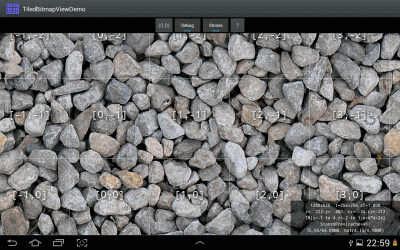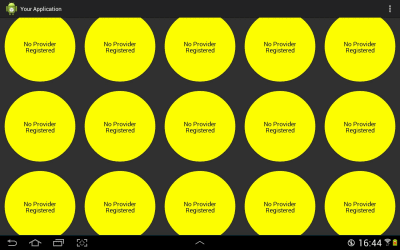This Android library provides a custom SurfaceView called TiledBitmapView whose contents are loaded tilewise from a provider - similar to the way map applications such as Google Maps load their content dynamically as the user scrolls around (although this library has absolutely nothing to do with mapping).
It supports devices running Android 2.3.3 (API Level: 10, GINGERBREAD_MR1) or greater.
The goal of this library is to be as lightweight and simple as possible, and has no dependencies of its own. It's not particularly feature heavy, it simply supports a scrollable view with dynamic content.
-
Demo App (Play Store | GitHub)
The
demosubdirectory of this repository contains a demo android app, which uses a data source with 25 tiles making up a repeating larger image of an area of stones. The screenshot below shows the demo with debug enabled, so you can see the tiles (click for bigger): -
Wolfram CA (Play Store | GitHub )
This app is used for viewing the successive generations of a 1-dimensional CA. As the user scrolls down, more tiles with successive generations are generated on the fly and rendered. The screenshot below also has debug enabled (click for bigger):
For Android Studio (which is based on Intellij IDEA) this consists of the following steps (at the time of writing anyway):
- Go to File -> Project Structure... and select category Modules on the left.
- Above the module list (in which your android project is currently present), click the green + and select Import Module
- Browse to and select the
librarysubdirectory of this repository. - In the wizard that starts, choose Create Module From Existing Sources. Step through the wizard, acceping the defaults to setup the module.
- Back in the Project Structure -> Modules view, the additional library module will now be present. Select your android app's module (not the library) and click the Dependencies tab.
- Click the small green + to the right, and select Module Dependency.... In the dialog that appears, select the library module. Done!
If you're using Gradle, check out the relevant
plugin docs. If you're using
Eclipse, do yourself a favour and install
Android Studio. ![]()
Simply add the following XML to the target layout file (with an ID and layout parameters that suit your design):
<net.nologin.meep.tbv.TiledBitmapView
android:id="@+id/MyTiledView"
android:layout_width="fill_parent"
android:layout_height="fill_parent"/>By default, the TiledBitmapView will produce dummy content until you're ready to implement your own provider. To check that the library is working, simply deploy your application to your device/emulator and the view should render content similar to the following (click for bigger):
The TiledBitmapView fetches the tiles to render from an implementation of the TileProvider
interface. By default, a very crude implementation (GenericTileProvider) is used, which generates
tiles with that hideous yellow circle on a gray background, that you see above.
Before writing your own implementation of this interface:
- Carefully read the TileProvider JavaDoc for information on the lifecycle of a provider and the role of each of the interface's methods.
- Look at the source for the DemoTileProvider to see an example of a provider that generates the desired tiles asynchronously, resulting in a more responsive application (Tiles appear as they become ready)
Now the <TiledBitmapView/> has been added to the layout as described above, we use findViewById(..)
in the Activity to get a reference to it, and call registerProvider(..) to register our custom
provider:
@Override
protected void onCreate(Bundle savedInstanceState) {
super.onCreate(savedInstanceState);
setContentView(R.layout.your_layout);
...
TiledBitmapView tbv = (TiledBitmapView)findViewById(R.id.MyTiledView);
tbv.registerProvider(new YourProvider(this));
...
}You can call setDebugEnabled(true) on the view to render the tile grid, the IDs of the tiles
and a small info box to give you invaluable help as you write your provider. It can impact
performance, so perhaps don't make the feature available to your end user.



